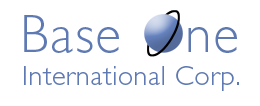|
Base One uses a Service Oriented Architecture (SOA), wherein application systems "are composed of independent, distributed and co-operating components called 'services'. These services can be distributed within or outside of the organizational physical boundaries and security domains. The various service components can exist on varying platforms and can be implemented using different programming languages."
(Reference: IBM Grid Services Programming and Application Enablement, Red Book,
2004)
The Base One SOA is distinctive in that
it is "database-centric", with communication between services modeled as adding, changing, deleting, and retrieving records in local and remote databases.
These databases are not necessarily those directly used for
production, but instead may exist solely for the purpose of staging
valuable data in an isolated environment and communicating with
outside systems. This model gives developers a higher efficiency, more
secure option than using SOAP messaging and XML Web Services for every
interaction between services. So, XML messages can be used only at the
appropriate boundaries, while simultaneously making recovery from
failures and high speed processing practical when there is a flood of
data and persistence matters.
Base One's design relies
on relational database technology (SQL), which is the proven, dominant standard for data storage and
access. This is the unifying theme throughout Base One's software.
The architecture builds on the unmatched strengths of
commercial database technology to deliver efficient, reliable, and secure processing of large amounts of data for large numbers of users.
Most developers familiar with building enterprise business applications find it straightforward to
use Base One's database-oriented approach for large scale computing problems. To the best of our knowledge, there are no other database components that offer
simpler solutions to the complex problems of building highly reliable,
production systems.
|
BFC's Windows programming tools and
middleware provide a unified, simple, consistent interface to
Microsoft, Oracle, IBM, Sybase, and MySQL databases, regardless of the platform
(OS) on which the databases run. Operations for storing and retrieving
data are expressed the same way whether programmed in .NET, COM, or MFC environments. The main Microsoft languages, Visual C++, C#,
Visual Basic, VB.NET, ASP, and ASP.NET, are supported by
the common database API (Application Programmer Interface). This API
provides comprehensive error and exception handling, with meaningful
messages, consistent treatment of unusual events, and automated
recovery from failures. The resulting applications run on
Windows web servers (IIS), Windows clients, and Windows servers.
Many of the solutions
delivered through Base One software are for advanced distributed
applications, so database-centric design is about a lot more than traditional database processing (i.e. information storage and retrieval using SQL). It's also about leveraging
DBMS capabilities for transaction processing and secure data storage to construct distributed systems, including grid and cluster computing applications and high performance, interactive, Internet applications.
Base One's Service Oriented Architecture supports large,
loosely coupled systems in which applications communicate with each
other through standardized database interfaces (instead of using
messages). Data Dictionaries allow programmatic and end-user
discovery of record layouts, field validation rules, available
indexes, and database logical structure. Each Data Dictionary acts as
a metadata repository and includes support for advanced data types
specifically optimized for databases (such as, Base One's patented Number
Class and Attached Objects).
|

